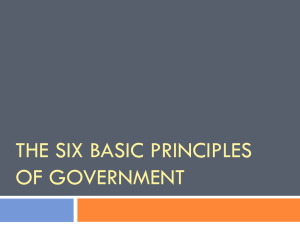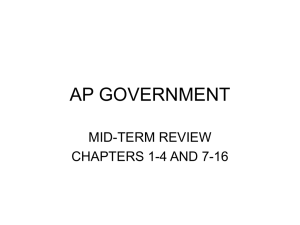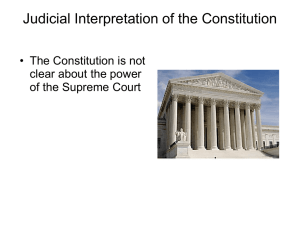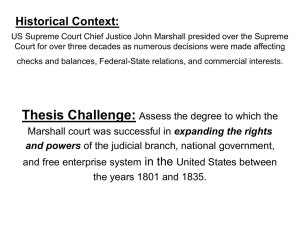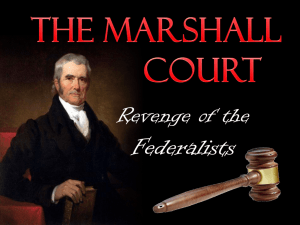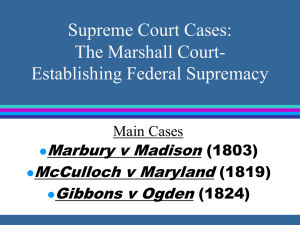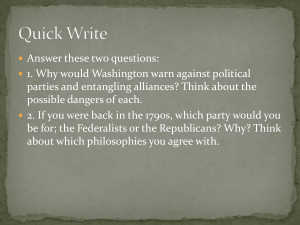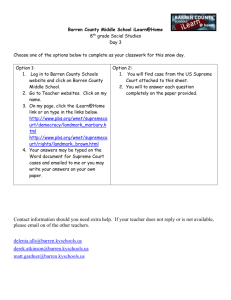1.7 Essential to Know
advertisement
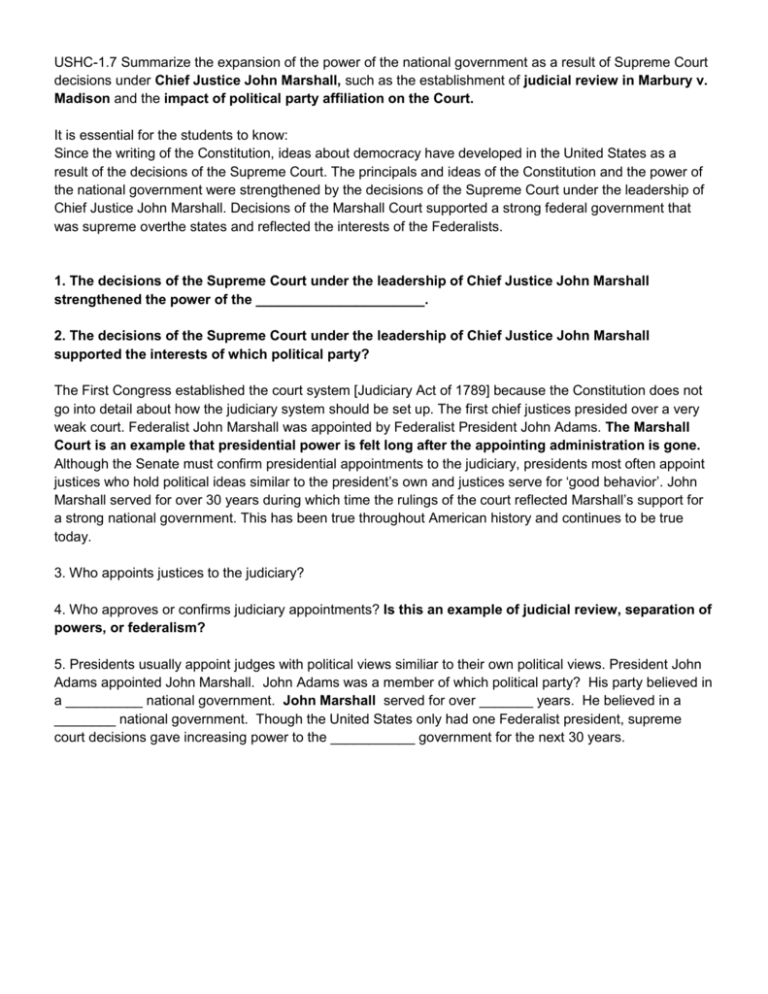
USHC-1.7 Summarize the expansion of the power of the national government as a result of Supreme Court decisions under Chief Justice John Marshall, such as the establishment of judicial review in Marbury v. Madison and the impact of political party affiliation on the Court. It is essential for the students to know: Since the writing of the Constitution, ideas about democracy have developed in the United States as a result of the decisions of the Supreme Court. The principals and ideas of the Constitution and the power of the national government were strengthened by the decisions of the Supreme Court under the leadership of Chief Justice John Marshall. Decisions of the Marshall Court supported a strong federal government that was supreme overthe states and reflected the interests of the Federalists. 1. The decisions of the Supreme Court under the leadership of Chief Justice John Marshall strengthened the power of the ______________________. 2. The decisions of the Supreme Court under the leadership of Chief Justice John Marshall supported the interests of which political party? The First Congress established the court system [Judiciary Act of 1789] because the Constitution does not go into detail about how the judiciary system should be set up. The first chief justices presided over a very weak court. Federalist John Marshall was appointed by Federalist President John Adams. The Marshall Court is an example that presidential power is felt long after the appointing administration is gone. Although the Senate must confirm presidential appointments to the judiciary, presidents most often appoint justices who hold political ideas similar to the president’s own and justices serve for ‘good behavior’. John Marshall served for over 30 years during which time the rulings of the court reflected Marshall’s support for a strong national government. This has been true throughout American history and continues to be true today. 3. Who appoints justices to the judiciary? 4. Who approves or confirms judiciary appointments? Is this an example of judicial review, separation of powers, or federalism? 5. Presidents usually appoint judges with political views similiar to their own political views. President John Adams appointed John Marshall. John Adams was a member of which political party? His party believed in a __________ national government. John Marshall served for over _______ years. He believed in a ________ national government. Though the United States only had one Federalist president, supreme court decisions gave increasing power to the ___________ government for the next 30 years. The ruling ofthe Marshall Court in Marbury v. Madison (1803) began the enduring precedent of judicial review as a vital part of the checks and balances system. Federalist William Marbury was appointed and confirmed as one of the ‘midnight’ judges. However his commission to a lower court had not been delivered before the Democratic Republicans took office and Secretary of State James Madison refused to deliver the commission. Marbury appealed to the Supreme Court for a court order [writ of mandamus] that would require Madison to deliver the commission. The court was authorized to issue such a writ by Congress. Marshall knew that if the court ordered the commission to be delivered to Marbury that the order would be ignored by Secretary of State Madison and the judicial branch would continue to be seen as powerless. Reading the Constitution closely, Marshall realized that the document does not give the power to issue such a writ to the Supreme Court under its original jurisdiction. The court could only hear such a case on appeal. The Marshall court ruled that, although Marbury deserved his commission, the court could not order that it be delivered because Congress could not give a power to the Supreme Court which the Constitution did not authorize. This was a landmark decision because it was the first time that the court claimed for itself the right of judicial review, the right to determine the constitutionality of an act of Congress. Since the decision did not have to be enforced by the executive branch, the court could not be undermined by its DemocraticRepublican rivals who now held the presidency. Jefferson and Madison had claimed the right to decide constitutionality of federal laws for the states in the Virginia and Kentucky Resolutions and the decision in Marbury countered that claim. By denying itself the right to issue the writ, the Marshall Court claimed for itself a far greater role- to determine what is constitutional and what is not. The Court under John Marshall asserted its role as a vital third branch of government that supported the principles of the Federalist Party. 6. Judicial review is part of the _____________________ system. 7. Secretary of State James Madison refused to deliver Marbury’s commission. Was James Madison a Federalist or a Democratic/Republican? 8. Congress gave the Supreme Court the power to issue the court order (writ of mandamus) for Marbury. Why did Chief Justice John Marshall not want to deliver the commission to Marbury? 9. What is the right of judicial review? Did this make the Supreme Court more powerful or less powerful? 10. Marbury v. Madison countered (opposed) the Virginia and Kentuky Resolutions. How did giving the right of judicial review to the courts take away power from the states? Although students need not remember the specifics or names of other cases they should understand that the Marshall Court continued to strengthen the role of the federal government. The Court ruled that only the federal government could control interstate commerce [Gibbons v Ogden]. The Court upheld the sanctity of contracts against encroached by state government [Dartmouth v Woodward]. The Court ruled that the state of Maryland could not inhibit the operations of the Bank of the United States by imposing a tax, thus upholdingthe right of the federal government to establish the national bank [McCulloch v Maryland]. The Court deniedthe right of the state of Georgia to limit the rights of the individual in a case related to Indian reservations[Worcester v Georgia]. This vital but political role of the Court will be evident again in decisions made by the Court in Dred Scott v Sanford and others. Complete the graphic organizer on the Marshall Court Marshall Court Strengthens the Role of the Federal Government 14. Worcester v. Georgia upheld the property rights of the Cherokee Indians. (page 270 textbook) Which President did not enforce the law? What did he say about John Marshall’s decision? Discussion: 1. Judicial Activism 2. The only qualification for Supreme Court Justices is “good behavior.” What is your definition of good behavior. 3. Supreme Court Justices are appointed for life to they will be able to make decisions based on right and wrong and not on whether they will get reelected. They are supposed to be free from politics. Yet, judicial decisions are not free from politics. History, of course, shows us they are not. Hence, the point at the beginning of the standard The Marshall Court is an exampleof presidential power being felt long after the appointing administration is gone. Also this leads to very nasty, partisan politics when new justices come up for nomination. Given the fact that decisions of the Supreme Court are not free from politics, do you believe the Supreme Court should have as much power as it does? Defend your answer. Include what limits the power of the Supreme Court.

